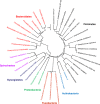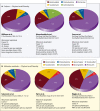Microbiology and treatment of acute apical abscesses
- PMID: 23554416
- PMCID: PMC3623375
- DOI: 10.1128/CMR.00082-12
Microbiology and treatment of acute apical abscesses
Abstract
Acute apical abscess is the most common form of dental abscess and is caused by infection of the root canal of the tooth. It is usually localized intraorally, but in some cases the apical abscess may spread and result in severe complications or even mortality. The reasons why dental root canal infections can become symptomatic and evolve to severe spreading and sometimes life-threatening abscesses remain elusive. Studies using culture and advanced molecular microbiology methods for microbial identification in apical abscesses have demonstrated a multispecies community conspicuously dominated by anaerobic bacteria. Species/phylotypes commonly found in these infections belong to the genera Fusobacterium, Parvimonas, Prevotella, Porphyromonas, Dialister, Streptococcus, and Treponema. Advances in DNA sequencing technologies and computational biology have substantially enhanced the knowledge of the microbiota associated with acute apical abscesses and shed some light on the etiopathogeny of this disease. Species richness and abundance and the resulting network of interactions among community members may affect the collective pathogenicity and contribute to the development of acute infections. Disease modifiers, including transient or permanent host-related factors, may also influence the development and severity of acute abscesses. This review focuses on the current evidence about the etiology and treatment of acute apical abscesses and how the process is influenced by host-related factors and proposes future directions in research, diagnosis, and therapeutic approaches to deal with this disease.
Figures





References
-
- Torabinejad M, Shabahang S. 2009. Pulp and periapical pathosis, p 49–67 In Torabinejad M, Walton RE. (ed), Endodontics. Principles and practice, 4th ed Saunders/Elsevier, St. Louis, MO
-
- Seltzer S, Farber PA. 1994. Microbiologic factors in endodontology. Oral Surg. Oral Med. Oral Pathol. 78:634–645 - PubMed
-
- Baumgartner JC. 1991. Microbiologic and pathologic aspects of endodontics. Curr. Opin. Dent. 1:737–743 - PubMed
-
- Siqueira JF., Jr 2002. Endodontic infections: concepts, paradigms, and perspectives. Oral Surg. Oral Med. Oral Pathol. Oral Radiol. Endod. 94:281–293 - PubMed
-
- Sasaki H, Stashenko P. 2012. Interrelationship of the pulp and apical periodontitis, p 277–299 In Hargreaves KM, Goodis HE, Tay FR. (ed), Seltzer and Bender's dental pulp, 2nd ed Quintessence Publishing, Chicago, IL
Publication types
MeSH terms
Substances
LinkOut - more resources
Full Text Sources
Other Literature Sources
Medical

